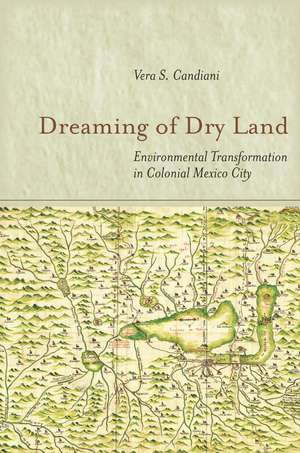Dreaming of Dry Land: Environmental Transformation in Colonial Mexico City
Autor Vera Candianien Limba Engleză Hardback – 3 iun 2014
Not long after the conquest, the City of Mexico's rise to become the crown jewel in the Spanish empire was compromised by the lakes that surrounded it. Their increasing propensity to overflow destroyed wealth and alarmed urban elites, who responded with what would become the most transformative and protracted drainage project in the early modern America—the Desagüe de Huehuetoca. Hundreds of technicians, thousands of indigenous workers, and millions of pesos were marshaled to realize a complex system of canals, tunnels, dams, floodgates, and reservoirs.
Vera S. Candiani's Dreaming of Dry Land weaves a narrative that describes what colonization was and looked like on the ground, and how it affected land, water, biota, humans, and the relationship among them, to explain the origins of our built and unbuilt landscapes. Connecting multiple historiographical traditions—history of science and technology, environmental history, social history, and Atlantic history—Candiani proposes that colonization was a class, not an ethnic or nation-based phenomenon, occurring simultaneously on both sides of an Atlantic, where state-building and empire-building were intertwined.
Vera S. Candiani's Dreaming of Dry Land weaves a narrative that describes what colonization was and looked like on the ground, and how it affected land, water, biota, humans, and the relationship among them, to explain the origins of our built and unbuilt landscapes. Connecting multiple historiographical traditions—history of science and technology, environmental history, social history, and Atlantic history—Candiani proposes that colonization was a class, not an ethnic or nation-based phenomenon, occurring simultaneously on both sides of an Atlantic, where state-building and empire-building were intertwined.
Preț: 448.82 lei
Preț vechi: 554.11 lei
-19% Nou
Puncte Express: 673
Preț estimativ în valută:
85.90€ • 88.53$ • 72.52£
85.90€ • 88.53$ • 72.52£
Carte disponibilă
Livrare economică 10-24 februarie
Livrare express 24-30 ianuarie pentru 37.48 lei
Preluare comenzi: 021 569.72.76
Specificații
ISBN-13: 9780804788052
ISBN-10: 0804788057
Pagini: 408
Dimensiuni: 152 x 229 x 28 mm
Greutate: 0.65 kg
Editura: Stanford University Press
Colecția Stanford University Press
ISBN-10: 0804788057
Pagini: 408
Dimensiuni: 152 x 229 x 28 mm
Greutate: 0.65 kg
Editura: Stanford University Press
Colecția Stanford University Press
Recenzii
"By placing class and nature at the center of her analysis, [Candiani] brings to light the complex interactions of social relations, class priorities, and knowledge making embedded in the design and conceptualization of the Desagüe. Furthermore, by placing human agency at the center of an environmental history of the Desagüe de Huehuetoca, Candiani's work bring fresh perspective to anyone interested in the relationship between colonialism, environmental governance, landscape transformation, and knowledge production."—Beth A. Bee, Social & Cultural Geography
"A comprehensive study of the Desagüe de Huehuetoca, [...], has nonetheless long remained a gap in [...] literature. Vera S. Candiani has now filled it with an innovative study . . . Candiani weaves the whole into a narrative alive with individuals who range from friars, viceroys, and engineers to native laborer, foremen, and local officials."—Andrew Sluyter, The AAG Review of Books
"In this original study, Vera S. Candiani challenges us to take a fresh look at the Desagüe, the two-century long Spanish endeavor to subdue the lacustrine environment around colonial Mexico City . . . Dreaming of Dry Land is an impressive piece of scholarship that is likely to attract scholarly attention for some time."—Christopher A. Woolley, Colonial Latin American Historical Review
"Dreaming of Dry Land is obviously the culmination of extensive archival research in Mexico and Spain. Equally important, it is rooted in a deep appreciation and understanding of the Basin of Mexico's hydrologic environment. In this regard, Candiani distinguishes herself as one of the best environmental scholars among historians."—William E. Doolittle, Journal of Historical Geography
"This ambitious and original study traces the history of an important engineering and environmental project in the area surrounding Mexico City during the Spanish colonial period. The author 'decolonizes' historical (mis)understandings of the Desagüe and, in the process, pushes back against narratives of progress and advancement that tend to come with looking at scientific change over time. The work succeeds admirably."—Jordana Dym, Skidmore College
"Candiani traces in detail the engineering and construction challenges of this pharaonic project, and the human decisions, rather than the natural conditions or technical constraints, primarily accounting for the history of the Desagüe. A stellar work in the historiography of early modern science and technology, Mexico, and the micro-physics of Spanish imperial rule."—Eric Van Young, University of California, San Diego
"Candiani traces in detail the engineering and construction challenges of this pharaonic project, and the human decisions, rather than the natural conditions or technical constraints, primarily accounting for the history of the Desagüe. A stellar work in the historiography of early modern science and technology, Mexico, and the micro-physics of Spanish imperial rule."—Eric Van Young, University of California, San Diego
Notă biografică
Born in Argentina, Vera S. Candiani is a historian of colonial Latin America who specializes in the confluence of history of technology, environmental history, and social history. She teaches at Princeton University.
Descriere
The book shows why and how the lakes that used to surround the City of Mexico disappeared, initiating the present environmental crisis of this megacity.




















